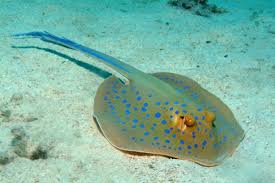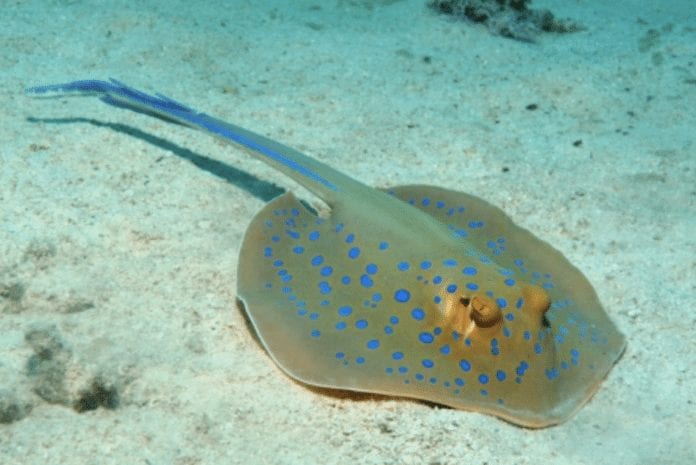Care Requirements for the Blue Spotted Stingray
By Christeena
- Blue Spotted Stingray: Bluespotted Ribbontail Ray or Blue Dot Stingray – Taeniura lymma
- Care Level: Expert
- Temperament: Aggressive
- Diet: Carnivore
- Reef Safe: No
- Max Size: 14-28”
- Minimum Tank Size: 150 gallons (300 gallons for adults)

The Blue Spotted Stingray, also known as the Bluespotted Ribbontail Ray or Blue Dot Stingray, is part of the Dasyatidae family of Stingrays originating from Indo-Pacific, Australia. The Blue Dot has a tan body with blue spots. This Stingray is an attractive bottom-dwelling fish that requires soft substrate as camouflage.
Tank Requirements for the Blue Spotted Stingray
As smaller animals, these rays can get by in a 150-gallon tank, but as they reach adulthood it’s a good idea to upgrade to a larger tank. Use caution with this Blue Spotted Ray as it is venomous and can sting for protection. Always be careful when netting the stingray or when it is not visible when performing maintenance in the aquarium. Never expose your Blue Spotted Stingray to copper-based medications. Make sure your ray doesn’t scratch its abdomen on the coarse substrate, as it can get infected. It’s important to allow your ray to camouflage itself and swim with the soft substrate.
Feeding & Care Difficulty of the Blue Spotted Stingray
While rays are exotic and extremely interesting, special feeding and housing requirements must be met. Only an expert hobbyist should attempt this animal in their aquarium. It might be difficult to get your Blue Dot Stingray to feed when first introduced into the aquarium. Encourage feeding by offering small pieces of cleaned squid or freshwater ghost shrimp. When your ray is feeding consistently, it can be fed shrimp, scallops, mollusks or crustaceans.
Keep Blue Spotted Stingrays in a good environment at a temperature between 72 and 78°F. Maintain a pH value of 8.1-8.4, a specific gravity of between 1.020-1.025, and dKH between 8-12.


















